The Use of Digital Social Networks and Engagement in Chilean Wine Industry
Abstract
1. Introduction
2. Literature Review
2.1. Social Networks and Engagement
2.2. The Wine Industry
3. Materials and Methods
3.1. Engagement Calculation
3.2. Network Analysis
4. Results
4.1. Main Findings
4.2. The Engagement
4.2.1. Results the Engagement in Vineyards
4.2.2. Engagement in the Different Post of Social Media
4.2.3. Variation in the Engagement of Vineyards on Social Media between 2008 and 2018
4.2.4. Correlation between Engagement and Social Media Metrics
4.3. Network Analysis
5. Discussion
6. Conclusions
Author Contributions
Funding
Data Availability Statement
Acknowledgments
Conflicts of Interest
Appendix A
| Vineyards | |||
|---|---|---|---|
| Viña Balduzzi | 31-07-2012 | 14-12-2015 | 16-10-2012 |
| Viña Bouchon Family | 08-09-2014 | 27-10-2014 | 03-09-2014 |
| Viña Casa Marin | 06-09-2011 | 01-10-2015 | 13-01-2010 |
| Viña Casas del Bosque | 04-07-2015 | 14-06-2013 | 30-06-2011 |
| Viña Concha y Toro | 10-07-2011 | 08-08-2012 | 30-01-2017 |
| Viña Cono Sur | 04-02-2013 | 05-02-2013 | 31-08-2018 |
| Viña Corral Victoria | 27-11-2015 | 01-07-2017 | 26-03-2014 |
| Viña De Martino | 15-10-2010 | 07-12-2012 | 09-03-2010 |
| Viña Gillmore Estate | 12-06-2011 | 30-08-2015 | 16-03-2010 |
| Viña Maipo | 02-04-2012 | 15-07-2016 | 29-08-2011 |
| Viña Misiones de Rengo | 07-05-2008 | 25-08-2014 | 14-02-2015 |
| Viña Montes | 06-12-2016 | 03-10-2012 | 13-02-2015 |
| Viña Montgras | 19-07-2010 | 12-04-2016 | 02-07-2010 |
| Viña San Esteban | 20-08-2009 | 02-03-2016 | 26-03-2012 |
| Viña Santa Carolina | 03-06-2009 | 11-03-2014 | 12-05-2010 |
| Viña Santa Cruz | 23-04-2017 | 19-12-2015 | 30-07-2013 |
| Viña Tarapaca | 12-07-2012 | 09-12-2016 | 13-10-2011 |
| Viña Undurraga | 01-01-2015 | 28-09-2015 | 17-08-2010 |
References
- Medina-Albaladejo, F.; Martínez-Carrión, J.; Ramon-Muñoz, J. El mercado mundial de vino y la competitividad de los países del hemisferio sur, 1961–2010. Am. Lat. Hist. Econ. 2014, 21, 40–83. [Google Scholar] [CrossRef]
- Costopoulou, C.; Ntaliani, M.; Ntalianis, F. Social media in Greek and German wineries Websites. In Proceedings of the 9th International Conference on Information, Intelligence, Systems and Applications (IISA), Zakynthos, Greece, 23–25 July 2018. [Google Scholar] [CrossRef]
- Sebastian, J.; Castillo, J.; Del, M.; Cortijo, C. Análisis de los factores explicativos de la rentabilidad de las empresas vinícolas de Castilla-La Mancha Analysis of explanatory factors of profitability for wine firms in Castilla-La Mancha. Rev. Fac. Cienc. Agrar. 2013, 45, 141–154. [Google Scholar]
- Geldes, C.; Felzensztein, C.; Turkina, E.; Durand, A. How does proximity affect interfirm marketing cooperation? A study of an agribusiness cluster. J. Bus. Res. 2015, 68, 263–272. [Google Scholar] [CrossRef]
- Asur, S.; Huberman, B.; Szabó, G.; Wang, C. Trends in Social Media: Persistence and Decay. In Proceedings of the 5th International AAAI Conference on Weblogs and Social Media, Barcelona, Spain, 11–21 July 2011. [Google Scholar] [CrossRef]
- Shane-Simpson, C.; Manago, A.; Gaggi, N.; Gillespie-Lynch, K. Why do college students prefer Facebook, Twitter, or Instagram? Site affordances, tensions between privacy and self-expression, and implications for social capital. Comput. Hum. Behav. 2018, 86, 276–288. [Google Scholar] [CrossRef]
- Peeroo, S.; Samy, M.; Jones, B. Customer engagement manifestations on Facebook pages of Tesco and Walmart. In Proceedings of the International Conference on Computing, Communication and Security (ICCCS), Pointe aux Piments, Mauritius, 4–5 December 2015. [Google Scholar] [CrossRef]
- Vivakaran, V.; Maraimalai, N. Digital brand management: A study on the factors affecting customers’ engagement in Facebook pages. In Proceedings of the International Conference on Smart Technologies and Management for Computing, Communication, Controls, Energy and Materials (ICSTM), Chennai, India, 6–8 May 2015. [Google Scholar] [CrossRef]
- Coursaris, C.; Van Osch, W.; Balogh, B. Do Facebook Likes Lead to Shares or Sales? Exploring the Empirical Links between Social Media Content, Brand Equity, Purchase Intention, and Engagement. In Proceedings of the 49th Hawaii International Conference on System Sciences (HICSS), Koloa, HI, USA, 5–8 January 2016. [Google Scholar] [CrossRef]
- Román, J.; Cancino, C.; Gallizo, J. Exploring features and opportunities of rapid-growth wine firms in Chile. Estud. Gerenc. 2017, 33, 115–123. [Google Scholar] [CrossRef]
- Aliste, E.; Bustos, B.; Gac, D.; Schirmer, R. Discursos sobre la viña y el vino: Nuevos territorios n el imaginario social. Rev. Geogr. Norte Gd. 2019, 72. [Google Scholar] [CrossRef]
- Cusmano, L.; Morrison, A.; Rabellotti, R. Catching up Trajectories in the Wine Sector: A Comparative Study of Chile, Italy, and South Africa. World Dev. 2010, 38, 1588–1602. [Google Scholar] [CrossRef]
- Varas, M.; Basso, F.; Maturana, S.; Pezoa, R.; Weyler, M. Measuring efficiency in the Chilean wine industry: A robust DEA approach. Appl. Econ. 2021, 53, 1092–1111. [Google Scholar] [CrossRef]
- Marolt, M.; Zimmermann, H.; Žnidaršič, A.; Pucihar, A. Exploring Social Customer Relationship Management Adoption in Micro, Small and Medium-Sized Enterprises. J. Theor. Appl. Electron. Commer. Res. 2020, 15, 38–58. [Google Scholar] [CrossRef]
- Belch, G.; Belch, M.; Kerr, G.; Waller, D.; Powell, I. Advertising: An Integrated Marketing Communication Perspective, 4th ed.; McGraw-Hill Connect: New York, NY, USA, 2020. [Google Scholar]
- Nicholson, B.; Nugroho, Y.; Rangaswamy, N. Social Media for Development: Outlining Debates, Theory and Praxis. Inf. Technol. Dev. 2016, 22, 357–363. [Google Scholar] [CrossRef]
- Kırcova, I.; Enginkaya, E. Social Media Marketing; Beta Yayınevi: İstanbul, Turkey, 2015. [Google Scholar]
- Tsimonis, G.; Dimitriadis, S. Brand Strategies in Social Media. Mark. Intell. Plan. 2014, 32, 328–344. [Google Scholar] [CrossRef]
- Clark, M.; Black, H.; Kimberly, J. Brand community integration and satisfaction with social media sites: A comparative study. J. Res. Interact. Mark. 2017, 11, 39–55. [Google Scholar] [CrossRef]
- Nadzir, M.; Harun, N.; Hassan, M. Social media engagement on Malaysian government agencies Facebook pages: An empirical analysis. In Proceedings of the Jordan International Joint Conference on Electrical Engineering and Information Technology (JEEIT), Amman, Jordan, 9–11 April 2019. [Google Scholar] [CrossRef]
- Kujur, F.; Singh, S. Visual Communication and Consumer-Brand Relationship on Social Networking Sites—Uses & Gratifications Theory Perspective. J. Theor. Appl. Electron. Commer. Res. 2020, 15, 30–47. [Google Scholar] [CrossRef]
- Cannell, D. Social Media Marketing and Online Business 2021; Independently Published; 2020; 820p, ISBN 979-8694757263. [Google Scholar]
- Balland, P.A.; Belso-Martínez, J.A.; Morrison, A. The Dynamics of Technical and Business Knowledge Networks in Industrial Clusters: Embeddedness, Status, or Proximity? Econ. Geogr. 2016, 92, 35–60. [Google Scholar] [CrossRef]
- Domene, M. Marketing Online 2.0: Cómo Atraer y Fidelizar Clientes en Internet; Colección Social Media; Grupo Anaya Comercial: Madrid, Spain, 2014. [Google Scholar]
- He, W.; Zha, S.; Li, L. Social media competitive analysis and text mining: A case study in the pizza industry. Int. J. Inf. Manag. 2013, 33, 464–472. [Google Scholar] [CrossRef]
- Kumar, A.; Bezawada, R.; Rishika, R.; Janakiraman, R.; Kannan, P. From Social to Sale: The Effects of Firm-Generated Content in Social Media on Customer Behavior. J. Mark. 2016, 80, 7–25. [Google Scholar] [CrossRef]
- Geldes, C.; Heredia, J.; Felzensztein, C.; Mora, M. Proximity as determinant of business cooperation for technological and non-technological innovations: A study of an agribusiness cluster. J. Bus. Ind. Mark. 2017, 32, 167–178. [Google Scholar] [CrossRef]
- Effing, R.; Hillegersberg, J.; Huibers, T. Social Media and Political Participation: Are Facebook, Twitter and YouTube Democratizing Our Political Systems? In Proceedings of the International Conference on Electronic Participation, Delft, The Netherlands, 29 August–1 September 2011. [Google Scholar] [CrossRef]
- Ashley, C.; Tuten, T. Creative Strategies in Social Media Marketing: An Exploratory Study of Branded Social Content and Consumer Engagement. Psychol. Mark. 2015, 32, 15–27. [Google Scholar] [CrossRef]
- Parveen, F.; Jaafar, N.; Ainin, S. Social media usage and organizational performance: Reflections of Malaysian social media managers. Telemat. Inform. 2015, 32, 67–78. [Google Scholar] [CrossRef]
- Kabadayi, S.; Price, K. Consumer brand engagement on Facebook: Liking and commenting behaviors. J. Res. Interact. Mark. 2014, 8. [Google Scholar] [CrossRef]
- Hootsuite. We Are Social; Global Digital Report 2020; Hootsuite: Vancouver, BC, Canada, 2020. [Google Scholar]
- Stec, C. Social Media Definitions: The Ultimate Glossary of Terms You Should Know; Hubspot: Cambridge, MA, USA, 2020. [Google Scholar]
- Fiegerman, M. How Twitter Could Still Blow it and Fade Away into Social Network Oblivion. 2016. Available online: https://mashable.com/2016/03/20/how-twitter-could-fade-away/ (accessed on 20 November 2020).
- Tsukayama, H. The Death of Twitter as We Know It. 2019. Available online: https://www.washingtonpost.com/news/the-switch/wp/2016/02/11/the-death-of-twitter-as-we-know-it/ (accessed on 27 November 2020).
- Duggan, M. Mobile Messaging and Social Media. 2015. Available online: https://www.pewresearch.org/internet/2015/08/19/mobile-messaging-and-social-media-2015/ (accessed on 3 November 2020).
- Reuters-Institute. Digital News Report 2020; Reuters-Institute: Oxford, UK, 2020. [Google Scholar]
- Heinonen, K. Consumer activity in social media: Managerial approaches to consumers’ social media behavior. J. Consum. Behav. 2011, 10, 356–364. [Google Scholar] [CrossRef]
- Hollebeek, L. Demystifying Customer Brand Engagement: Exploring the Loyalty Nexus. J. Mark. Manag. 2011, 27, 785–807. [Google Scholar] [CrossRef]
- Taylor, M.; Kent, M. Dialogic Engagement: Clarifying Foundational Concepts. J. Public Relat. Res. 2014, 26. [Google Scholar] [CrossRef]
- Schivinski, B.; Christodoulides, G.; Dabrowski, D. Measuring Consumers’ Engagement With Brand-Related Social-Media Content: Development and Validation of a Scale that Identifies Levels of Social-Media Engagement with Brands. J. Advert. Res. 2016, 56. [Google Scholar] [CrossRef]
- Harrigan, P.; Evers, U.; Miles, M.; Daly, T. Customer engagement with tourism social media brands. Tour. Manag. 2017, 59, 597–609. [Google Scholar] [CrossRef]
- Bandari, R.; Asur, S.; Huberman, B. The Pulse of News in Social Media: Forecasting Popularity. In Proceedings of the 6th International AAAI Conference on Weblogs and Social Media, ICWSM 2012, Dublin, Ireland, 4–7 June 2012. [Google Scholar]
- Raimondo-Anselmino, N.; Sambrana, A.; Cardoso, A. Medios tradicionales y redes sociales en Internet: Un análisis de los posteos compartidos por los diarios argentinos Clarín y La Nación en Facebook (2010–2015). Astrolabio Nueva Época 2017, 19, 32–68. [Google Scholar]
- Vivek, S.; Beatty, S.; Morgan, R. Customer Engagement: Exploring Customer Relationships Beyond Purchase. J. Mark. Theory Pract. 2012, 20, 127–145. [Google Scholar] [CrossRef]
- van Doorn, J.; Lemon, K.; Mittal, V.; Nass, S.; Pick, D.; Pirner, P.; Verhoef, P. Customer Engagement Behavior: Theoretical Foundations and Research Directions. J. Serv. Res. 2010, 13, 253–266. [Google Scholar] [CrossRef]
- Alalwan, A.; Rana, N.; Dwivedi, Y.; Algharabat, R. Social media in marketing: A review and analysis of the existing literature. Telemat. Inform. 2017, 34, 1177–1190. [Google Scholar] [CrossRef]
- OIV. Organización Mundial de la Viña y el Vino. Aspectos de la Coyuntura Mundial. Situación del Sector en 2020; OIV: Paris, France, 2020. [Google Scholar]
- Todaro, R.; Reyes, N. Comercio, Género y Equidad en América Latina: Generando Conocimiento Para la Acción Política. Relaciones de Género en la Industria Vitivinícola Empleo y Sistemas de Cuidado; Universidad Nacional de Colombia: Bogota, Colombia, 2009. [Google Scholar]
- SAG. Informe Ejecutivo de Producción de Vinos Chile 2020; SAG: Santiago, Chile, 2020. [Google Scholar]
- Diaz, J.; Valdes, R.; Hernandez, N. El vino chileno en Europa. Un análisis del posicionamiento en el mercado alemán. Rev. Fac. Cienc. Agrar. Univ. Cuyo 2015, 47, 159–171. [Google Scholar]
- Sampieri, R.; Collado, C.; Lucio, P. Metodología de la Investigación; McGraw-Hill Education: New York, NY, USA, 2010. [Google Scholar]
- Pimienta, R. Encuestas probabilísticas vs. no probabilísticas. Política Cult. 2000, 13, 263–276. [Google Scholar]
- Monje, C. Metodología de la Investigación Cuantitativa y Cualitativa—Guía Didáctica; Universidad Surcolombiana, Facultad de Ciencias Sociales y Humanas: Huila, Colombia, 2011. [Google Scholar]
- Vishnu, M.; Sigurdsson, V.; Magne, N.; Fagerstrøm, A.; Sørensen, H.; Gunnars, H.; Foxall, G. How to grow brand post engagement on Facebook and Twitter for airlines? An empirical investigation of design and content factors. J. Air Transp. Manag. 2019, 79, 101678. [Google Scholar] [CrossRef]
- Borgatti, S.; Everett, M.; Freeman, L. UCINET for Windows: Software for Social Network Analysis. 2002. Available online: https://sites.google.com/site/ucinetsoftware/home (accessed on 30 October 2020).
- Velázquez, A.; Aguilar, N. Manual Introductorio al anáLisis de Las Redes Sociales. 2005. Available online: https://docplayer.es/934089-Manual-introductorio-al-analisis-de-redes-sociales.html (accessed on 30 October 2020).
- Hanneman, R.; Riddle, M. Introduction to Social Network Methods; University of California: Riverside, CA, USA, 2005. [Google Scholar]
- Vargas-Quesada, B.; Minguillo, D.; Chinchilla-Rodríguez, Z.; Moya-Anegon, F. Estructura de la colaboración científica española en Biblioteconomía y Documentación. Rev. Rev. Interam. 2010, 33, 105–123. [Google Scholar]
- Yep, J.; Brown, M.; Fagliarone, G.; Shulman, J. Influential Players in Twitter Networks of Libraries at Primarily Undergraduate Institutions. J. Acad. Librariansh. 2017, 43. [Google Scholar] [CrossRef]
- Carah, N. Like, Comment, Share: Alcohol Brand Activity on Facebook; Foundation for Alcohol Research & Education: Canberra, Australia, 2014. [Google Scholar]
- Coronado-Padilla, J. Escalas de medición. Paradigmas 2007, 2, 104–125. [Google Scholar]
- Chandes, J.; Paché, G. Pensar la acción colectiva en el contexto de la logística humanitaria: Las lecciones del sismo de pisco. J. Econ. Financ. Adm. Sci. 2009, 14, 47–61. [Google Scholar]
- Maghsoudi, M.; Pazirandeh, A. Visibility, resource sharing and performance in supply chain relationships: Insights from humanitarian practitioners. Supply Chain Manag. Int. J. 2016, 1, 25–139. [Google Scholar] [CrossRef]
- Tatham, P.; Spens, K. Towards a Humanitarian Logistics Knowledge Management System. Disaster Prev. Manag. 2011, 20, 6–26. [Google Scholar] [CrossRef]
- Szolnoki, G.; Dolan, R.; Forbes, S.; Thach, L.; Goodman, S. Using social media for consumer interaction: An international comparison of winery adoption and activity. Wine Econ. Policy 2018, 7, 109–119. [Google Scholar] [CrossRef]
- Galati, A.; Crescimanno, M.; Tinervia, S.; Fagnani, F. Social media as a strategic marketing tool in the Sicilian wine industry: Evidence from Facebook. Wine Econ. Policy 2017, 6, 40–47. [Google Scholar] [CrossRef]
- Larreina, M.; Aguado, R. Beyond the cluster: How wine drives regional economy to success: “Oenopolis”, the case of Rioja. Int. J. Wine Bus. Res. 2008, 20, 153–170. [Google Scholar] [CrossRef]
- Boschma, R. Proximity and Innovation: A Critical Assessment. Reg. Stud. 2005, 39, 61–74. [Google Scholar] [CrossRef]
- Smiesko, I. Criminal Liability of Facebook Reaction Buttons in Environment of the Slovak Republic as a Form of Hate Speech. Soc. Iurisprud. 2016, 4, 213–234. [Google Scholar]
- Zell, A.L.; Moeller, L. Are You Happy for Me on Facebook? The Potential Importance of Likes and Comments. Comput. Hum. Behav. 2018, 78, 26–33. [Google Scholar] [CrossRef]
- Knol, A.; Tan, Y.H. The Cultivation of Information Infrastructures for International Trade: Stakeholder Challenges and Engagement Reasons. J. Theor. Appl. Electron. Commer. Res. 2018, 13, 106–117. [Google Scholar] [CrossRef]
- Cohan, P. Goliath Strikes Back: How Traditional Retailers Are Winning Back Customers from Ecommerce Startups, 1st ed.; Apress: New York, NY, USA, 2020. [Google Scholar]
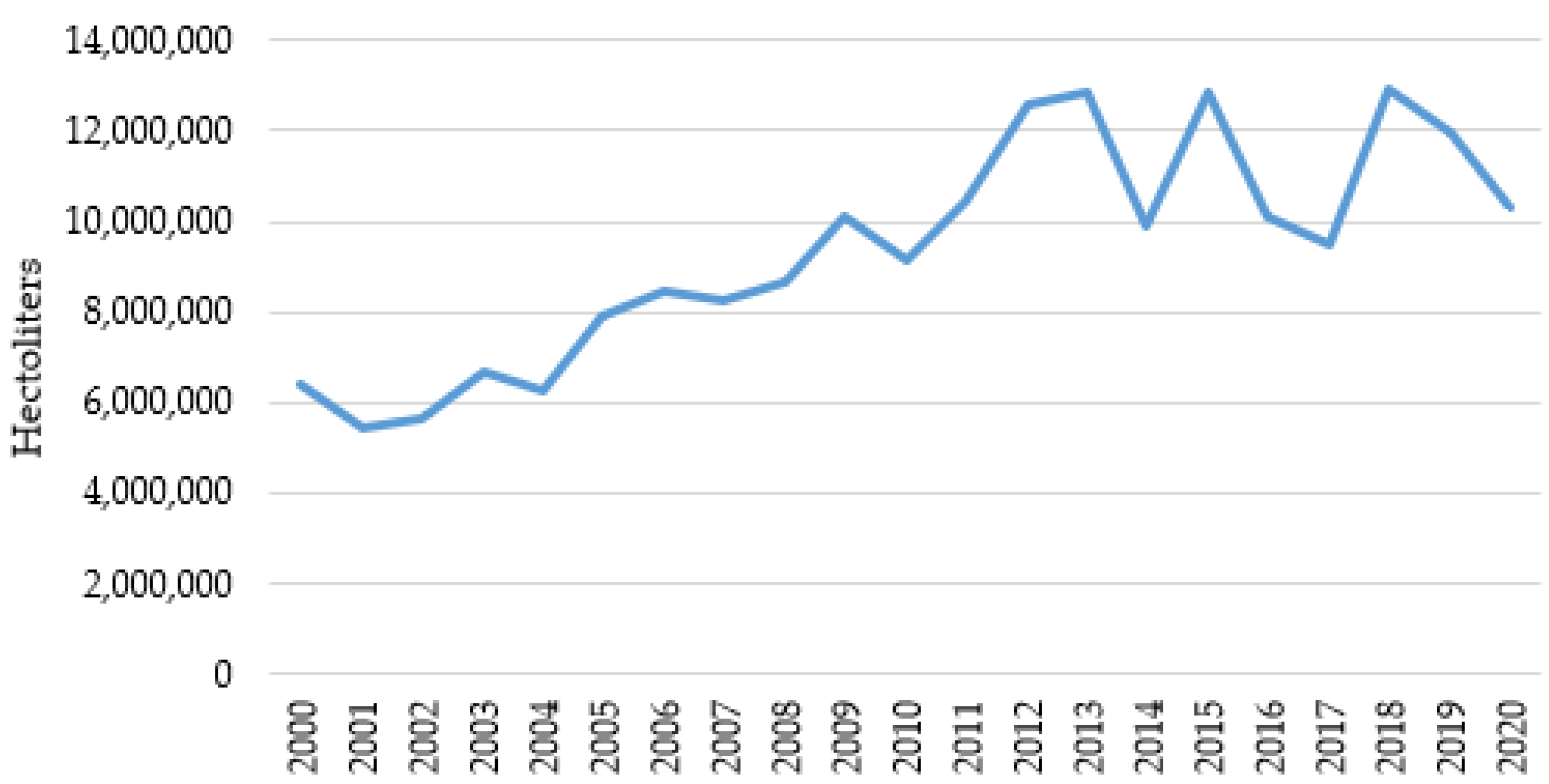
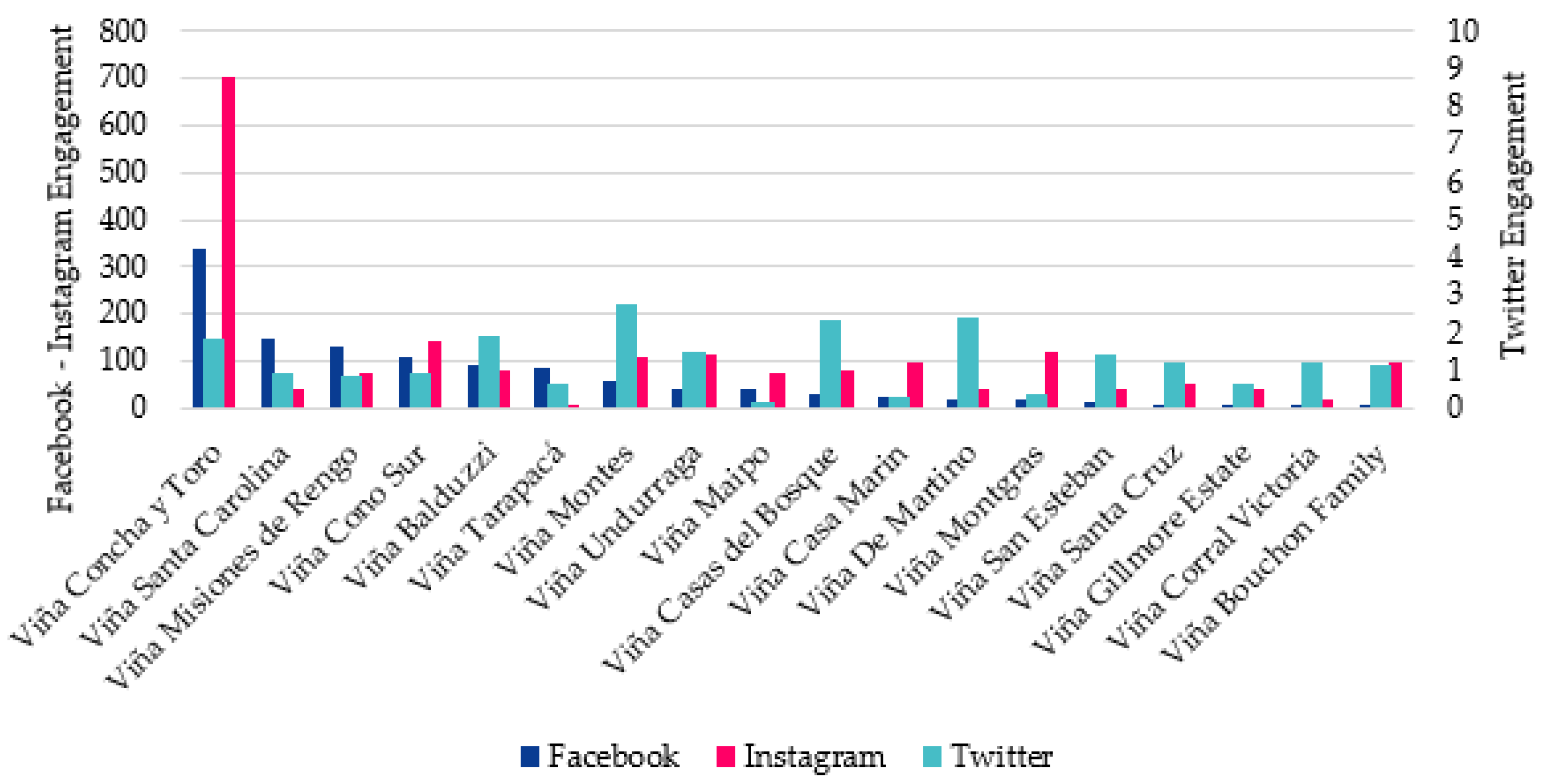


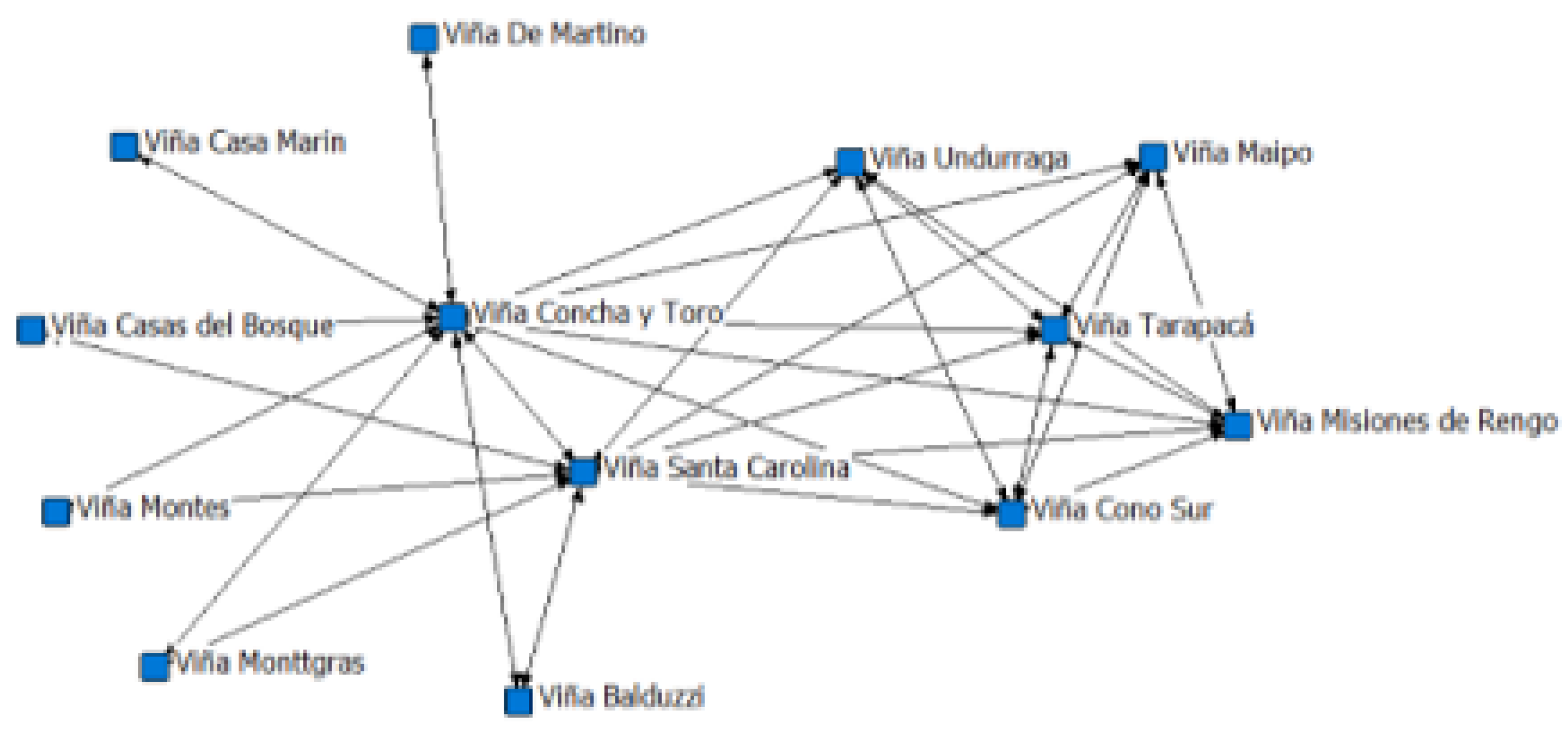
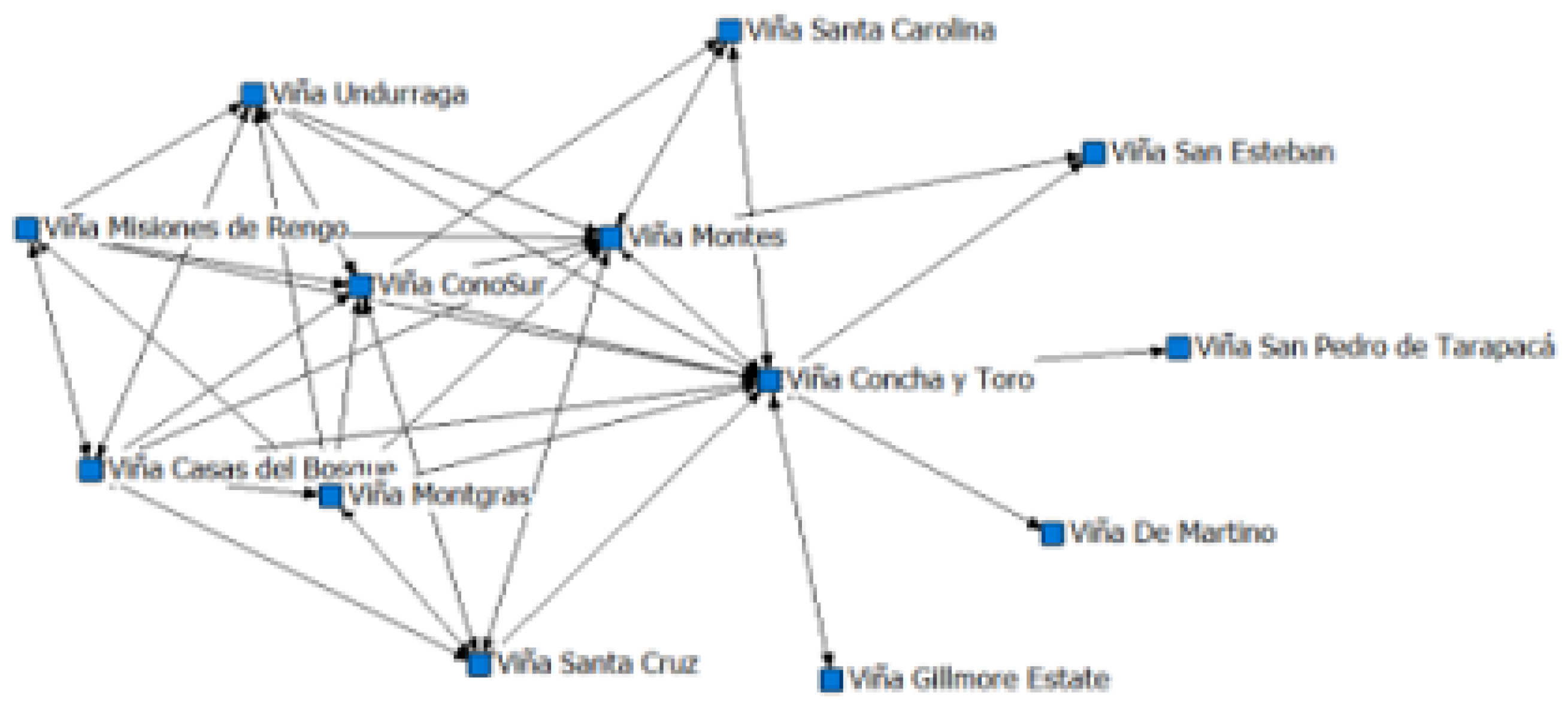
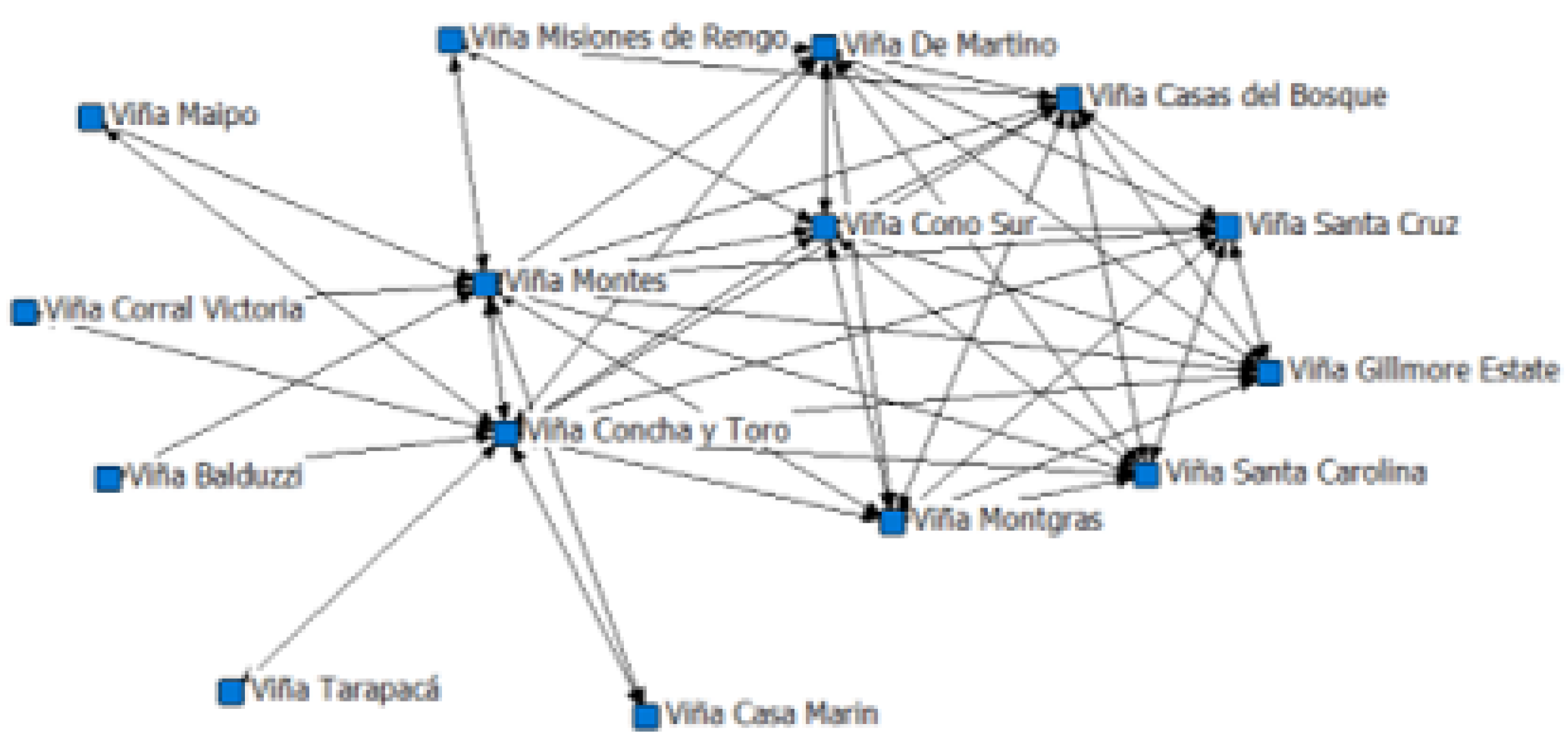
| Important Grade | Social Media | Mean | Standard Deviation | Mode | Score 1 |
|---|---|---|---|---|---|
| “Social media for the marketing of the wine industry” | 2.75 | 1.00 | 3 | 68.8 | |
| 2.81 | 1.05 | 4 | 70.3 | ||
| 1.81 | 1.11 | 2 | 45.3 | ||
| “The importance of metrics of engagement on Facebook” | Comments | 2.38 | 0.96 | 3 | 59.4 |
| Shares | 2.50 | 0.97 | 2 | 62.5 | |
| Likes | 2.50 | 1.03 | 3 | 62.5 | |
| “The importance of metrics of engagement on Twitter” | Retweet | 2.19 | 1.11 | 2 | 54.7 |
| Favorites | 2.00 | 1.11 | 1 | 50.0 | |
| Comments | 2.06 | 1.12 | 1 | 51.6 | |
| “The importance of metrics of engagement on Instagram” | Likes | 2.94 | 0.93 | 3 | 73.4 |
| Comments | 2.82 | 0.98 | 3 | 70.3 |
| Vineyars | |||||||||||
|---|---|---|---|---|---|---|---|---|---|---|---|
| C. Post | Photos | Videos | Events | Surveys | Photos | Videos | Carousel | Tweets | Retweets | Replies | |
| Viña Balduzzi | 29.3 | 96.4 | 14.7 | 0.0 | 0.0 | 76.3 | 95.2 | 83.9 | 0.2 | 4.0 | 2.2 |
| Viña Bouchon Family | 5.0 | 6.1 | 9.4 | 3.3 | 0.0 | 96.5 | 91.8 | 122.2 | 0.8 | 5.4 | 3.6 |
| Viña Casa Marin | 13.0 | 32.4 | 37.1 | 11.7 | 0.0 | 98.1 | 0.0 | 0.0 | 0.2 | 2.9 | 0.7 |
| Viña Casas del Bosque | 47.2 | 27.1 | 18.6 | 0.0 | 0.0 | 75.9 | 66.9 | 125.2 | 0.3 | 2.6 | 2.3 |
| Viña Concha y Toro | 405.2 | 217.1 | 118.8 | 0.0 | 0.0 | 712.9 | 537.0 | 0.0 | 0.3 | 5.4 | 1.9 |
| Viña Cono Sur | 188.8 | 98.3 | 72.9 | 0.0 | 6.1 | 143.7 | 130.2 | 119.5 | 2.2 | 15.4 | 2.0 |
| Viña Corral Victoria | 0.5 | 8.7 | 21.1 | 0.9 | 0.0 | 19.8 | 24.9 | 28.6 | 0.5 | 12.3 | 2.3 |
| Viña De Martino | 18.0 | 19.6 | 36.0 | 0.0 | 0.0 | 42.3 | 47.8 | 71.3 | 0.3 | 3.4 | 2.4 |
| Viña Gillmore Estate | 4.8 | 9.0 | 2.5 | 0.0 | 0.0 | 39.2 | 40.3 | 0.0 | 0.1 | 14.4 | 4.1 |
| Viña Maipo | 37.5 | 41.4 | 10.0 | 0.0 | 0.2 | 46.0 | 91.6 | 179.8 | 0.1 | 1.3 | 0.2 |
| Viña Misiones de Rengo | 366.8 | 88.0 | 259.0 | 0.0 | 0.6 | 72.4 | 68.8 | 115.5 | 0.7 | 2.3 | 0.9 |
| Viña Montes | 53.3 | 61.4 | 36.7 | 3.1 | 0.0 | 109.1 | 109.8 | 235.2 | 1.4 | 4.8 | 3.3 |
| Viña Montgras | 7.4 | 19.9 | 17.3 | 5.6 | 0.0 | 118.1 | 105.3 | 155.5 | 0.0 | 1.6 | 0.5 |
| Viña San Esteban | 5.7 | 14.2 | 20.2 | 8.6 | 0.0 | 41.4 | 37.9 | 41.6 | 0.4 | 4.7 | 2.1 |
| Viña Santa Carolina | 129.2 | 159.3 | 61.2 | 0.0 | 382.9 | 43.0 | 48.6 | 79.2 | 0.2 | 2.8 | 1.6 |
| Viña Santa Cruz | 5.7 | 9.1 | 12.4 | 0.0 | 0.0 | 2.6 | 0.0 | 0.0 | 0.4 | 12.3 | 5.9 |
| Viña Tarapacá | 20.0 | 102.7 | 44.6 | 0.0 | 0.0 | 37.0 | 43.5 | 44.7 | 0.1 | 1.9 | 0.8 |
| Viña Undurraga | 38.4 | 41.5 | 28.9 | 0.0 | 0.0 | 120.7 | 75.8 | 107.8 | 0.2 | 4.3 | 2.2 |
| Followers | Post | Reactions | Comments | Shares | Engagement | |
|---|---|---|---|---|---|---|
| Followers | 1 | |||||
| Post | 0.358 | 1 | ||||
| Reactions | 0.895 ** | 0.554 * | 1 | |||
| Comments | 0.721 ** | 0.559 * | 0.834 ** | 1 | ||
| Shares | 0.941 ** | 0.506 * | 0.958 ** | 0.863 ** | 1 | |
| Engagement | 0.909 ** | 0.477 * | 0.977 ** | 0.857 ** | 0.961 ** | 1 |
| Followers | Post | Likes | Comments | Engagement | |
|---|---|---|---|---|---|
| Followers | 1 | ||||
| Post | 0.334 | 1 | |||
| Likes | 0.908 ** | 0.453 * | 1 | ||
| Comments | 0.883 ** | 0.529 * | 0.941 ** | 1 | |
| Engagement | 0.881 ** | 0.044 * | 0.897 ** | 0.795 ** | 1 |
| Tweets | Followers | Relipes | Favorites | Mentions | Engagement | |
|---|---|---|---|---|---|---|
| Tweets | 1 | |||||
| Followers | 0.757 ** | 1 | ||||
| Relipes | 0.674 ** | 0.292 | 1 | |||
| Favorites | 0.525 * | 0.550 * | 0.382 | 1 | ||
| Mentions | −0.127 | −0.045 | 0.197 | −0.056 | 1 | |
| Engagement | 0.153 | 0.462 | 0.042 | 0.765 ** | 0.01 | 1 |
Publisher’s Note: MDPI stays neutral with regard to jurisdictional claims in published maps and institutional affiliations. |
© 2021 by the authors. Licensee MDPI, Basel, Switzerland. This article is an open access article distributed under the terms and conditions of the Creative Commons Attribution (CC BY) license (https://creativecommons.org/licenses/by/4.0/).
Share and Cite
Egaña, F.; Pezoa-Fuentes, C.; Roco, L. The Use of Digital Social Networks and Engagement in Chilean Wine Industry. J. Theor. Appl. Electron. Commer. Res. 2021, 16, 1248-1265. https://doi.org/10.3390/jtaer16050070
Egaña F, Pezoa-Fuentes C, Roco L. The Use of Digital Social Networks and Engagement in Chilean Wine Industry. Journal of Theoretical and Applied Electronic Commerce Research. 2021; 16(5):1248-1265. https://doi.org/10.3390/jtaer16050070
Chicago/Turabian StyleEgaña, Francisco, Claudia Pezoa-Fuentes, and Lisandro Roco. 2021. "The Use of Digital Social Networks and Engagement in Chilean Wine Industry" Journal of Theoretical and Applied Electronic Commerce Research 16, no. 5: 1248-1265. https://doi.org/10.3390/jtaer16050070
APA StyleEgaña, F., Pezoa-Fuentes, C., & Roco, L. (2021). The Use of Digital Social Networks and Engagement in Chilean Wine Industry. Journal of Theoretical and Applied Electronic Commerce Research, 16(5), 1248-1265. https://doi.org/10.3390/jtaer16050070






